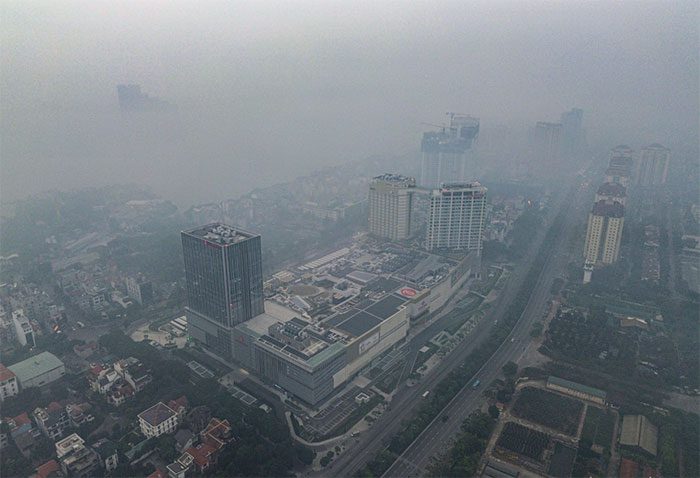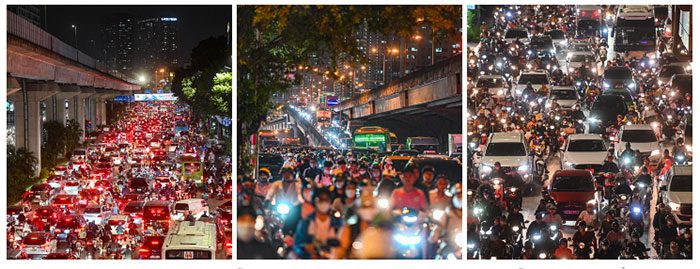Experts believe that regardless of winter or summer, the sources of air pollution remain consistent. However, the characteristics of each season lead to different trends in dust levels, which can either increase or decrease pollution indices.
In recent days, air quality monitoring systems have continuously issued warnings about hazardous pollution levels in Hanoi.

Tall buildings in Hanoi disappear in the fog and fine dust – (Photo: HONG QUANG)
Statistics from AirVisual reveal that during a 16-day period (from November 18 to December 3), Hanoi’s daily pollution index was only at a moderate level for one day (December 1) when it rained. The remaining 15 days were reported with pollution levels in the red zone – harmful to health.
Hanoi consistently ranks among the most polluted cities worldwide, with PM2.5 levels exceeding the WHO’s warning limits by dozens of times.
In an interview with Tuổi Trẻ Online, Dr. Hoang Duong Tung – President of the Vietnam Clean Air Network and former Deputy Director of the General Department of Environment – stated that after years of monitoring, this situation is not unusual.
The period from October of the previous year to March of the following year typically sees a significant rise in the AQI (Air Quality Index), much higher than in the other months of the year. This is due to poorly controlled emissions, compounded by winter climate factors that severely impact air pollution.
Millions of vehicles and construction sites emit dust and pollution
* So, is winter the cause, sir?
– Winter is not the cause of air pollution. To say that would be misleading. Whether it is winter or summer, the sources of pollution remain the same. However, the characteristics of each season cause the levels of dust to behave differently.
In summer, frequent rain and strong winds help disperse or wash away fine dust. Conversely, winter brings calm winds and little rain, coupled with thermal inversions and dense fog that hinder air dispersion, causing pollutants to linger at low levels or not be washed away. Meanwhile, emissions continue to rise, pushing the AQI higher.


Millions of vehicles on the road every day are a significant source of air pollution – (Photo: HONG QUANG).
The main causes of pollution in Hanoi can be categorized into four primary groups:
- First, emissions from vehicles. According to statistics from the Hanoi Department of Transport, the city currently has about 6.5 million motorbikes. These vehicles do not require regular inspections, leading to uncontrolled emissions. Additionally, over 1 million cars traveling daily throughout the capital contribute significantly to emissions, despite being subject to periodic inspections.
- Second, emissions from industrial production activities and waste burning.
- Third, emissions from craft villages, particularly recycling villages that lack emission controls.
- Fourth, emissions from construction sites.
* Based on analysis, which areas typically have the highest pollution indices?
– Monitoring from various observation systems indicates that high levels of air pollution are not fixed to one location. This is because PM2.5 dust moves with air currents, resulting in varying pollution indices even within a district or city.
Hanoi has made efforts but has not succeeded; residents can only “hope for the weather”
* How does PM2.5 harm us, and what other pollutants exist that contribute to air pollution, sir?
– Fine dust PM2.5 is a silent killer that infiltrates our bodies daily. More dangerously, these ultra-fine particles can penetrate lung sacs, lung veins, and enter the human bloodstream. According to the WHO, PM2.5 dust is the fourth leading cause of premature death worldwide. All countries are concerned about this index.
In addition to PM2.5, the Ministry of Natural Resources and Environment has identified five other indices for monitoring: NOx, SO2, CO, CH4, and NMVOC. However, I believe that currently, the concentrations of these substances are not as concerning as PM2.5.

On November 29, Hanoi was the second most polluted city globally, according to AirVisual – (Photo: AirVisual).
* What can residents do to distinguish between fog and air pollution? Do you have any recommendations for the public on polluted days?
– To easily identify, residents should monitor websites that update air quality data, such as the Environmental Pollution Control Department, the U.S. Embassy’s information page, the Hanoi Department of Natural Resources and Environment, or other reputable applications.
On days with high pollution levels, individuals with pre-existing respiratory conditions or young children should stay indoors or limit outdoor activities. Families with the means should consider purchasing air purifiers. When going outside, residents should wear glasses and masks, and wash their eyes and rinse their mouths upon returning home.
* Are we currently relying on the weather to address this situation, hoping for rain or seasonal winds to blow away the pollution?
– Hanoi has recognized the pollution issue for many years. The city has implemented measures to mitigate this situation, such as increasing green spaces, developing electric buses, relocating industrial facilities outside the inner city, addressing straw burning after harvest, and banning the use of traditional coal stoves…
However, pollution levels continue to rise. I assess that the reason is that the city has not effectively controlled internal pollution sources. In other words, Hanoi has made efforts, but the results have not been sufficient. This leads to a situation where, during each pollution episode, residents can only “hope for the weather” to provide some rain or seasonal winds to disperse the dense and gloomy layer of fine dust.



















































